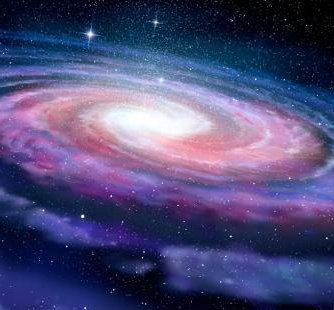THE EXPANSION OF THE UNIVERSE 1

THE EXPANSION OF THE UNIVERSE PART 1
A Look at the night sky gives a powerful impression of a changeless universe. True, clouds drift across the moon, the sky rotates around the polar star, and over longer times the moon itself waxes and wanes and the moon and planets move against the background of stars. But we know that these are merely local phenomena caused by motions within our solar system. Beyond the planets, the stars seem motionless.
Of course, the stars do move, at speeds ranging up to a few hundred kilometers per second, so in a year a fast star might travel ten thousand million kilometers or so. This is a thousand times less than the distance to even the closest stars, so their apparent position in the sky changes very slowly. (For instance, the relatively fast star known as Barnard's star is at a distance of about 56 million million kilometers; it moves across the line of sight at about 89 kilometers per second or 2.8 thousand million kilometers per year, and in consequence its apparent position shifts in one year by an angle of 0.0029 degrees.) Astronomers call the shift in the apparent position of nearby stars in the sky a "proper motion." The apparent position in the sky of the more distant stars change so slowly that their proper motion cannot be detected with even the most patient observation.
We are going to see here that this impression of change-lessness is illusory. The observations that we will discuss in this chapter reveal that the universe is in a state of violent explosion, in which the great islands of stars known as galaxies are rushing apart at speeds approaching the speed of light. Further, we can extrapolate this explosion backward in time and conclude that all the galaxies must have been much closer at the same time in the past—so close, in fact, that neither galaxies nor stars nor even atoms or atomic nuclei could have had a separate existence. This is the era we call "the early universe,".
Our knowledge of the expansion of the universe rests entirely on the fact that astronomers are able to measure the motion of a luminous body in a direction directly along the line of sight much more accurately than they can measure its motion at right angles to the line of sight. The technique makes use of a familiar property of any sort of wave motion, known as the Doppler effect. When we observe a sound or light wave from a source at rest, the time between the arrival of wave crests at our instruments is the same as the time between crests as they leave the source. On the other hand, if the source is moving away from us, the time between arrivals of successive wave crests is increased over the time between their departures from the source, because each crest has a little farther to go on its journey to us than the crest before. The time between crests is just the wavelength divided by the speed of the wave, so a wave sent out by a source moving away from us will appear to have a longer wavelength than if the source were at rest. (Specifically, the fractional increase in the wavelength is given by the ratio of the speed of the wave source to the speed of the wave itself.) Similarly, if the source is moving toward us, the time between arrivals of wave crests is decreased because each successive crest has a shorter distance to go, and the wave appears to have a shorter wavelength. It is just as if a traveling salesman were to send a letter home regularly once a week during his travels: while he is traveling away from home, each successive letter will have a little farther to go than the one before, so his letters will arrive a little more than a week apart; on the homeward leg of his journey, each successive letter will have a shorter distance to travel, so they will arrive more frequently than once a week.
It is easy these days to observe the Doppler effect on sound waves—just go out to the edge of a highway and notice that the engine of a fast automobile sounds higher pitched (i.e., a shorter wavelength) when the auto is approaching than when it is going away. The effect was apparently first pointed out for both light and sound waves by Johann Christian Doppler, professor of mathematics at the Realschule in Prague, in 1842.The Doppler effect for sound waves was tested by the Dutch meteorologist Christopher Heinrich Dietrich Buys-Ballot in an endearing experiment in 1845—as a moving source of sound he used an orchestra of trumpeters standing in an open car of a railroad train, whizzing through the Dutch countryside near Utrecht.
Doppler thought that his effect might explain the different colors of stars. The light from stars that happen to be moving away from the earth would be shifted toward longer wavelengths, and since red light has a wavelength longer than the average wavelength for visible light, such a star might appear redder than average. Similarly, light from stars that happen to be moving toward the earth would be shifted toward shorter wavelengths, so the star might appear unusually blue. It was soon pointed out by Buys-Ballot and others that the Doppler effect has essentially nothing to do with the color of a star. It is true that the blue light from a receding star is shifted toward the red, but at the same time some of the star's normally invisible ultraviolet light is shifted into the blue part of the visible spectrum, so the overall color hardly changes. Stars have different colors chiefly because they have different surface temperatures.
However, the Doppler effect did begin to be of enormous importance to astronomy in 1868, when it was applied to the study of individual spectral lines. It had been discovered years earlier, by the Munich optician Joseph Frauenhofer in 1814-1815, that when light from the sun is allowed to pass through a slit and then through a glass prism, the resulting spectrum of colors is crossed with hundreds of dark lines, each one an image of the slit. (A few of these lines had been noticed even earlier, by William Hyde Wollaston in 1802, but were not carefully studied at that time.) The dark lines were always found at the same colors, each corresponding to a definite wavelength of light. The same dark spectral lines were also found by Frauenhofer in the same positions in the spectrum of the moon and the brighter stars. It was soon realized that these dark lines are produced by the selective absorption of light of certain definite wavelengths, as the light passes from the hot surface of a star through its cooler outer atmosphere, Each line is due to the absorption of light by a specific chemical element, so it became possible to determine that the elements on the sun, such as sodium, iron, magnesium, calcium, and chromium, are the same as those found on earth. (Today we know that the wavelengths of the dark lines are just those for which a photon of that wavelength would have precisely the right energy to raise the atom from a state of lower energy to one of its excited states.)
 THE EXPANSION OF THE UNIVERSE 2
THE EXPANSION OF THE UNIVERSE 2

Vulnerability is the essence of romance. It’s the art of being uncalculated, the willingness to look foolish, the courage to say, ‘This is me, and I’m interested in you enough to show you my flaws with the hope that you may embrace me for all that I am but, more important, all that I am not.’
---Ashton Kutcher






